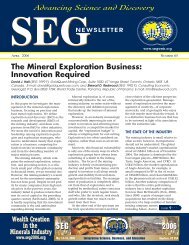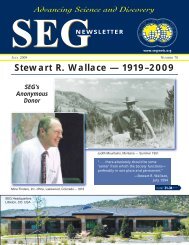SEG 45 Final_qx4 - Society of Economic Geologists
SEG 45 Final_qx4 - Society of Economic Geologists
SEG 45 Final_qx4 - Society of Economic Geologists
Create successful ePaper yourself
Turn your PDF publications into a flip-book with our unique Google optimized e-Paper software.
12 <strong>SEG</strong> NEWSLETTER No 63 • OCTOBER 2005<br />
... from 11<br />
7482000N<br />
7481000N<br />
7480000N<br />
7479000N<br />
13<br />
Exploring for Deposits Under Deep Cover Using Geochemistry (Continued)<br />
473000E 474000E<br />
475000E 24 476000E<br />
10<br />
Cu ppb<br />
Analyses <strong>of</strong> the soils showed that<br />
zones <strong>of</strong> high conductivity <strong>of</strong> soil-water<br />
slurries is due to the dissolution <strong>of</strong> NaCl<br />
(Na is shown in Fig. 6). Figure 6 also<br />
shows As and Se by Enzyme Leach, and<br />
Cu by Enzyme Leach, Mobile Metal Ions<br />
(MMI), and aqua regia. Enzyme Leach<br />
and MMI are proprietary leach methods<br />
designed to extract the weakly soluble<br />
fraction <strong>of</strong> metals, whereas aqua regia<br />
is a strong reagent that dissolves a<br />
much higher proportion <strong>of</strong> the total element<br />
in the soil. The active reagents in<br />
the Enzyme Leach solution are hydrogen<br />
peroxide and gluconic acid, the former<br />
solubilizing manganese oxides and<br />
their contained metals, with the gluconic<br />
acid stabilizing the metals in solution.<br />
In the soils from Spence, Enzyme<br />
Leach dissolves approximately the same<br />
amounts <strong>of</strong> elements as deionized<br />
water, but provides more reproducible<br />
analyses. The formulation <strong>of</strong> the MMI<br />
leach has not been revealed, but contains<br />
reagents that extract the most<br />
readily soluble fraction <strong>of</strong> elements,<br />
including those in carbonates.<br />
Sodium, As, and Se are all enriched<br />
in the soils lying above the fracture<br />
zone over the deposit and in the soils<br />
13<br />
Groundwater<br />
Flow<br />
14<br />
14<br />
19 191<br />
195<br />
1200 200<br />
121<br />
812<br />
10<br />
224<br />
88<br />
48<br />
25<br />
955<br />
1180<br />
4490<br />
53<br />
9<br />
41<br />
127 27<br />
12<br />
29<br />
Boundary between<br />
saline and non-saline<br />
waters<br />
Approximate Limits<br />
<strong>of</strong> Mineralization<br />
above the eastern fracture zone. Copper<br />
is enriched only in soils over the<br />
deposit. The anomaly/background contrast<br />
for Cu is much better for Enzyme<br />
Leach and MMI analyses than for aqua<br />
regia (Fig. 6). Much <strong>of</strong> the anomalous<br />
Cu in soils over the deposit is hosted by<br />
carbonate minerals. Analyses after<br />
extraction by ammonium acetate, a<br />
reagent that specifically dissolves carbonates,<br />
shows even higher values for<br />
Cu than MMI, but similar<br />
anomaly/background contrast<br />
(Cameron et al., 2004).<br />
We have interpreted these results to<br />
be caused by pumping <strong>of</strong> saline basement<br />
waters to the surface during earthquake<br />
activity (Cameron et al., 2002,<br />
2004). We interpret the data to indicate<br />
two faults in the basement, one directly<br />
along the axis <strong>of</strong> the deposit, and the<br />
other coincident with the eastern fracture<br />
zone. Saline water with high contents<br />
<strong>of</strong> As and Se were moved to the<br />
surface above the deposit and above the<br />
eastern fracture zone. Copper is only<br />
enriched in groundwaters within the<br />
deposit and these were entrained by the<br />
rising basement waters and taken to the<br />
surface. There is no increase in Cu in<br />
473000E 474000E<br />
475000E 476000E<br />
60 0<br />
15<br />
Mo, ppb<br />
24<br />
263<br />
105<br />
354<br />
<strong>45</strong><br />
2<br />
53<br />
66<br />
Soil Traverse<br />
63<br />
5<br />
18<br />
221<br />
222<br />
25<br />
33<br />
38<br />
soils above the eastern fracture zone.<br />
Drilling has shown the basement in this<br />
area to be barren. The above scenario is<br />
summarized in Figure 7. Saline water<br />
moves up from the basement along the<br />
axis <strong>of</strong> the deposit, where it mixes with<br />
meteoric water flowing in from the east.<br />
During earthquake activity, the basement<br />
water, plus mineralized water<br />
bathing the deposit, is forced to the surface.<br />
As noted by Woodall (2005), structures<br />
form pathways for magma, fluids,<br />
and energy. Thus, the interpreted fault<br />
zone along the axis <strong>of</strong> the deposit could<br />
have provided a pathway for porphyry<br />
magma, hypogene fluids, the fracturing<br />
<strong>of</strong> the mostly impermeable cover gravels<br />
during reactivation, and the movement<br />
<strong>of</strong> groundwaters to the surface.<br />
These points are unproven, but with<br />
mining <strong>of</strong> the deposit now commenced<br />
by BHP-Billiton, more definitive answers<br />
are expected.<br />
DISCUSSION AND<br />
CONCLUSIONS<br />
7<br />
40<br />
69<br />
Approximate Limits<br />
<strong>of</strong> Mineralization<br />
FIGURE 5. Plots <strong>of</strong> Cu and Mo (both in ppb) in groundwaters from in and around the Spence deposit. The line running roughly north-south<br />
near the axis <strong>of</strong> the deposit on the Cu plot separates low salinity meteoric waters to the east from saline deep formation waters to the<br />
west (Fig. 3). Within the deposit, higher values for Cu occur in both types <strong>of</strong> water, but are absent in the waters flowing away from the<br />
deposit to the southwest. By contrast, higher values <strong>of</strong> Mo are present in the downflow waters. The location <strong>of</strong> the soil sampling traverse is<br />
shown in the Mo plot. Eastings and northings in meters.<br />
The use <strong>of</strong> soil geochemistry in the<br />
search for buried deposits requires that<br />
32<br />
9<br />
54<br />
136<br />
9






